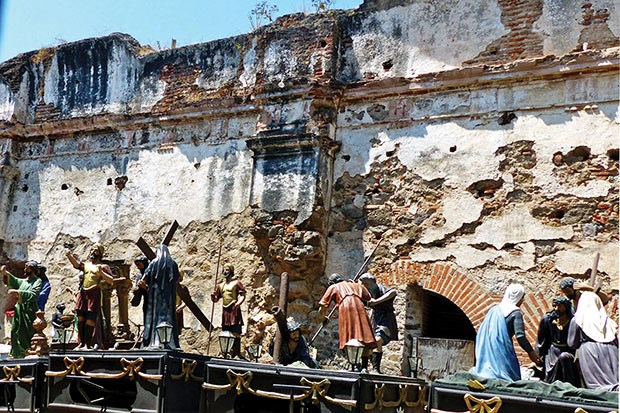Cruising through the Panama Canal to San Diego offers us a string of riveting Central American excursions, including a memorable daytrip from Puerto Quetzal to Antigua.
With other early birds, we disembark the Veendam, stream past marimba musicians and through a handicraft marketplace to our waiting coach. “Welcome,” greets guide Karen, “today we’ll visit our colonial capital in the central highlands, heart of the Mayan world.” Ninety minutes of rolling countryside, lush forests and distant volcano views bring us to Guatemala’s World Heritage city.
Passing several earthquake-damaged buildings, our walk winds along narrow raised sidewalks and crosses cobbled streets bustling with pedestrians and traffic, including tuk-tuk taxis. Smiling villagers loaded with hand-woven textiles, musical instruments and jewelry approach us to sell their wares.
Purple-blossomed jacarandas shade the plaza where Church of Mercy stands unscathed. Two short bell towers flank its white-filigreed, lemon yellow façade. Atop, we sight San Pedro Nolasco, 13th-century founder of this Catholic order.
This was Antigua’s first monastery. Inside, we learn Mercedarians helped heretics escape the Spanish inquisition and later supported families of convicts. In turn, appreciative prisoners created the mosaics still decorating stout interior columns.
The luxurious sanctuary and cloister were built with wide arches to better withstand earthquakes, such as the one that destroyed 3,000 buildings in 1717.
Heading onward, we notice religious sculptures inside off-street enclosures.
“Those are carried during Holy Week,” Karen explains. “From Ash Wednesday to Good Friday, a stream of processions parade along this street which is carpeted with flowers and coloured sawdust.
“It sometimes takes over a hundred men to shoulder some of the enormous floats.”
We soon pass under the 17th century Santa Catalina Arch, a covered overhead passageway built to protect reclusive nuns from public view.
Saint Joseph Cathedral stands in baroque splendor. Constructed originally in 1554 and destroyed repeatedly by earthquakes, only the front portion remains; skeletal ruins behind recall its original immensity and grandeur.
Exiting past 17th-century university buildings, we enter the grounds of Santo Domingo Monastery founded in 1538. Abandoned for centuries after an earthquake, it once boasted two grand towers with 10 bells. Its fountain survives in the refurbished courtyard. Because much of this city twice suffered similar destruction, authorities moved the capital to Guatemala City in 1776.
Part of the demolished monastery has been transformed into today’s Hotel Casa Santo Domingo. Seated at tables amid floral gardens, we enjoy a typical Guatemalan lunch of rice, black beans, chicken, beef, fresh guacamole and handmade corn tortillas.
Restored monastery treasures recovered from rubble fill an onsite art gallery. After admiring this collection of religious art and artifacts, we stroll gracious grounds where stands a prominent Ceiba tree. Mayans considered this the tree of life, its magnificent branches forming crosses that show the way. Spanish priests utilized their lore to promote Christianity.
And proving a different delight, the Jade Museum offers visitors an overview of Mesoamerican jade. Here, an archaeologist discusses 3,000 years of its importance to cultures as far away as Costa Rica and southwestern Mexico.
Travel Writers’ Tales is an independent travel article syndicate that offers professionally written travel articles to newspaper editors and publishers. To check out more, visit www.travelwriterstales.com.



